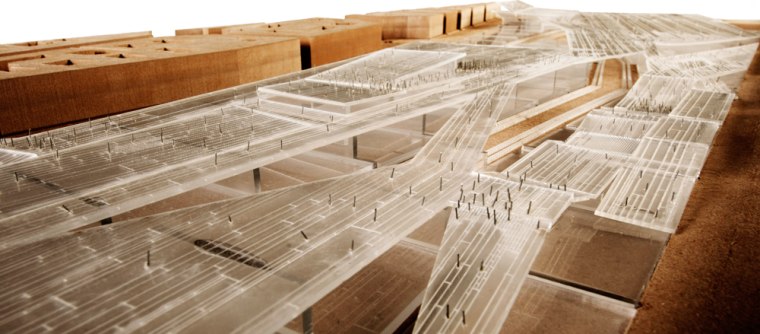The band takes center stage, the fans surge forward and the sheer power of the crowd’s excitement amplifies the sound of their favorite songs — providing enough energy, in fact, to move a train.
It could happen in the Crowd Farm, a conceptual design by two graduate students at the Massachusetts Institute of Technology that seeks to milk the mechanical movement of hundreds or thousands of assembled people to produce electrical power.
In principal, a large-scale version of the setup could harness the collective energy of commuters bustling toward subway stations, shoppers marching through mega malls or fans dancing at a rock concert. Already, the students have shown how the simple act of sitting on a stool can generate enough power to turn on four LED lights.
James Graham and Thaddeus Jusczyk, graduate students at MIT’s School of Architecture and Planning in Cambridge, Mass., said they envision their Crowd Farm more as a learning tool than an efficient energy source, at least in the near future. Even so, the idea builds upon the emerging consensus that power generation in the coming decades will need to rely on sustainable resources, whether water, wind, the sun or our own bodies.
“We engage with the city in a very physical and bodily way, every day, even though people don’t really think about it like that,” Graham said. “Our project tries to make that connection visible through this balance between capturing and using energy.”
Graham said moving to New York City on the day of the citywide blackout in 2003 and joining in the throng of pedestrians walking over the Williamsburg Bridge to Brooklyn inspired him to think about capturing the collective power of crowds.
Pacing in his apartment, he said, wouldn’t generate much power — each step would be just enough to light two 60 Watt light bulbs for a split second. But the aggregate power of 28,527 steps could power a moving passenger train for the same length of time. And a space shuttle launch? Graham and Jusczyk figured about 84 million strides should do the trick, leading one of their project reviewers to quip, “That’s one small step for man, eighty-four million, one-hundred sixty-two thousand, two hundred and three steps for mankind.”
The students’ proposal follows a long line of ideas in which human energy powers everything from bicycle lights to hand-crank radios. Researchers also have developed a variety of devices and surfaces, composed mainly of crystals or ceramics, that produce an electric charge when put under stress, a concept known as piezoelectricity.
The Crowd Farm concept relies on the related principle that mechanical movement can be converted into electricity, though on a larger scale in which the mechanics would be supplied by a spongy floor in which embedded blocks move under the weight of passing pedestrians. The conversion process itself could be handled by a generator that uses a rotating coil and electromagnets to produce an electric current from the mechanical movement.
Michael Sorkin, a New York City-based architect and president of Terreform Inc., a non-profit organization focused on urban and environmental research and intervention, said the Crowd Farm idea may not be entirely new but fits within the laudable goal of producing non-polluting energy.
“Even more fundamental,” Sorkin said, “is to think about the design of cities from the perspective of using the body as the primary means of circulation and energy in the first place.” For example, he said, it’s probably more efficient to design walk-up apartments than to power an elevator based on other people striding up the sidewalk.
Even so, with billions of people walking around the planet, Sorkin said, “if there’s a sensible, sustainable way of capturing that energy, it’s a win-win.”
For architects and urban designers, Graham said another challenge is to make people aware of their surroundings. Calling upon passersby to help light their way through a public building might be one way of redefining how people interact with urban spaces — and perhaps helping out with the electric bill.
Graham and Jusczyk generated a buzz last October at the Venice Biennale, a major contemporary art exhibition, and in January at an Italian architectural school, where they encouraged passersby to sit on a “power stool.” The added weight on the stool turned a flywheel that in turn powered a generator that lit up four LED lights.
“It was amazing to see how fascinated people were with it,” Graham said. “I’ve never before seen someone sit down again and again and again. People actually took pleasure in seeing that it was doing something.”
The students took their concept a few steps farther with a project that re-imagines a transportation hub and public space within the Italian city of Torino in the year 2050, where portions of an event area, athletic field and regional train and subway platforms are imbued with pressure-responsive units. High-volume sections of the flooring or stairs could be overlaid with special mats to capture the energy of a crowd, Graham said, or key areas could be embedded with variously sized electricity-generating boxes in the sub-flooring.
In April, the conceptual design won top honors in a student competition sponsored by the Switzerland-based Holcim Foundation for Sustainable Construction. Graham agrees with Sorkin that transforming the concept into a cost-effective system on a large scale would require a dramatic ramping up of current technology.
“We joke that we’re at the level of computers in the ‘60s when they were giants and clunky and took up entire rooms,” Graham said.
Nevertheless, the team takes inspiration from an old anecdote about Thomas Edison and a simple but effective turnstile. When visitors toured Edison’s summer property, the inventor allegedly asked them to pass through a peculiar turnstile. In response to their bemused queries, Edison would tell them good-naturedly that they had just helped him pump several gallons of water from his well into his storage tank.
